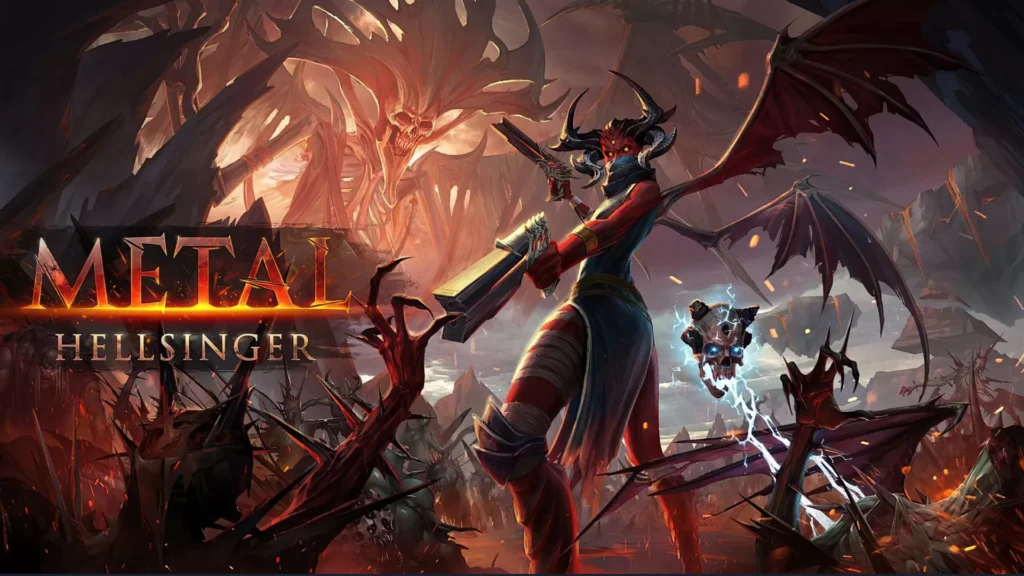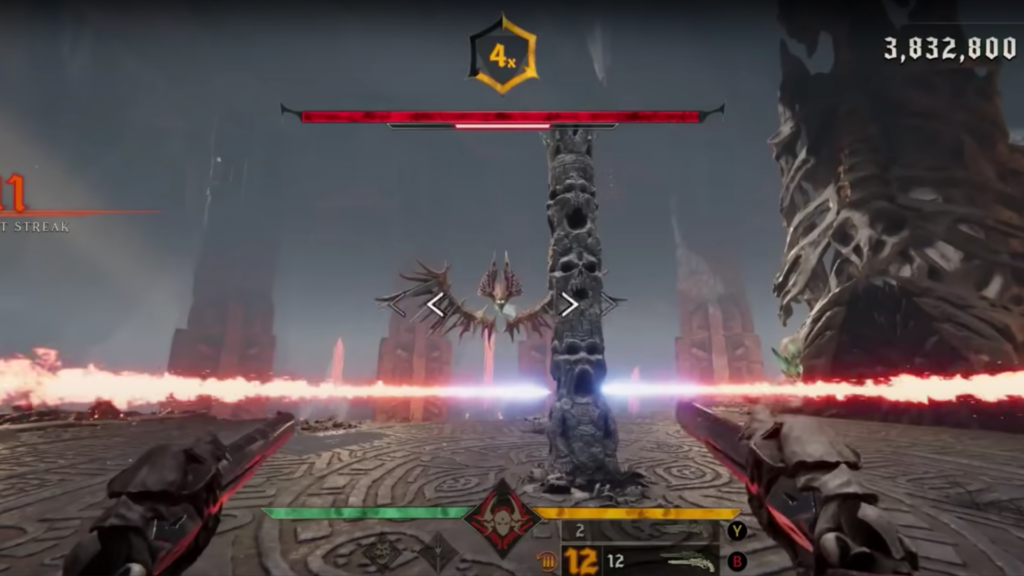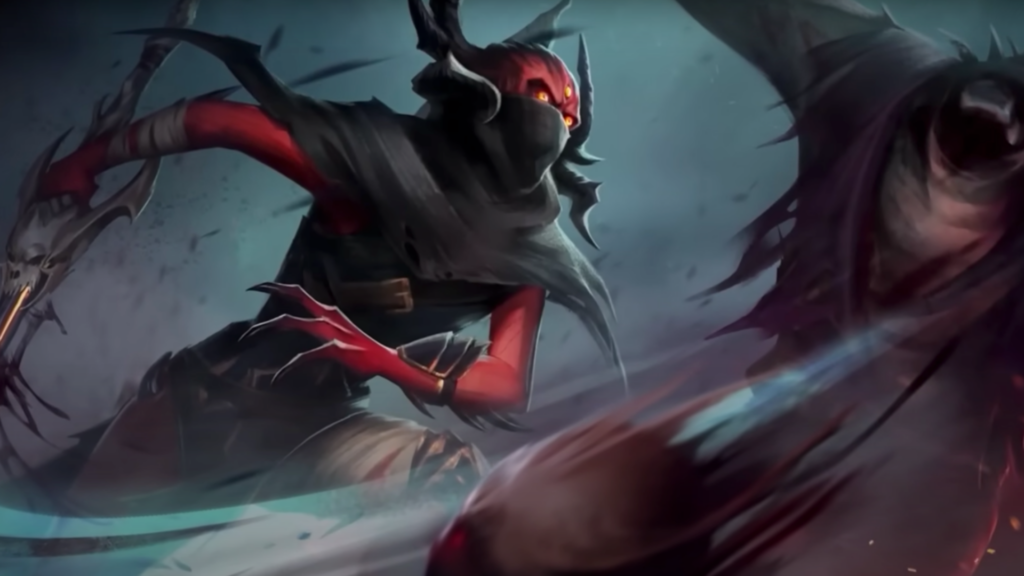Metal: Hellsinger Review

Metal: Hellsinger is the latest game by The Outsiders, a collective founded by ex-DICE developers. The Stockholm-based team revealed the title two years ago and it finally saw its release recently on PC, PlayStation 5, and Xbox Series. The title drew much interest in a recent trailer announcing its release date at Summer Games Fest this year with a surprising (or maybe unsurprising) day-one release on Xbox Game Pass.
Overview
The game is a first-person shooter mixed with beat-matching rhythm mechanics. Players are tasked with taking the mantle of the Hellsinger, a demonic deity banished by the game’s antagonist, the ruler of Hell simply referred to as The Judge, and blasting their way through hordes of demonic entities to a pulsating metal soundtrack.
As a game so clearly inspired by DOOM 2016, it’s going to be difficult not to make comparisons to it and its contemporary, 2020’s DOOM Eternal. Does Metal: Hellsinger live up to its promise and does it have the chops to stand alongside genre heavyweights like DOOM Eternal?
The gameplay has a great central concept that isn’t executed quite as well as it could have been

Upon starting Metal: Hellsinger, players will be freed from their slumber by Troy Baker himself in skull form. In Metal: Hellsinger, Troy Baker is referred to as Paz and acts as the game’s narrator and also the first weapon that players will become accustomed to, along with a simple sword. In the game’s first stage, players are introduced to the game’s main hook, which is a gamification of background music via the encouragement to fire projectiles, jump, dash, use melee attacks, reload, and utilize other abilities such as each weapon’s various power-ups to the beat of the game’s rhythms. Essentially, every action the player can take is tied to this central mechanic.
This is also visualized via a red marker that works as an optical metronome that aligns with the crosshair at the exact moment that the driving beat of the song hits. The mechanic can feel a bit odd at first, especially with things like melee takedown executions a la DOOM 2016 and reloading, since most people (everyone?) will be used to reloading as soon as the opportunity arises. However, the core gimmick doesn’t take too long to get accustomed to and you will soon find yourself bobbing your head to the rhythm while exploding demon heads like tiny little grapes.
Which is good because good performance in the game is reliant upon your ability to successfully fire, reload, and perform other actions in sync with the music. Bonus damage and other benefits are afforded to the player for doing so, as well as a score modifier similar to character action games or other music games like Guitar Hero that give the player a visual representation of how well they are performing.
The score modifier maxes out at 16x, which is also when the vocals of a song’s track will dynamically kick in, signaling that you are excelling at heavy metal demon slaughter. At times, I found myself entering a similar trancelike state as DOOM Eternal where I was zoning out, only acting on muscle memory and impulse. Hitting the dashes and jumps to the beat aren’t always necessary, but you won’t want to interrupt the flow–even during downtime between combat encounters.
As great as the game’s flow can be, it can at times feel a bit simple and restrictive. While hearing the crunch of a shotgun reload and echoing boom to the toms on a track can feel rewarding when the game is firing on all cylinders, it all kind of comes down a bit when the feeling that you are constantly doing the same thing kicks in.
While there are a few weapons at your disposal, like dual pistols, a shotgun, an explosive crossbow, and throwable boomerang swords, it’s extremely easy to find two weapons you feel really comfortable with and only use those for your entire time in the game. This is especially reinforced by the fact that, aside from Paz and your melee weapon (which are equipped by default), you’re only allowed to carry two weapons at a time.
For me, I ended up sticking to the pistols because of their effective range, rapid-fire, and how they reward headshots and the crossbow for dealing heavy damage to large groups of enemies. As much as I liked the shotgun and the super cool and unique boomerang swords, the game never put me in a position to need or even want to use either of them.
This brings up another issue which is the enemy and encounter design. While there are a handful of enemies, such as your typical fodder mobs with melee and ranged variants, as well as more difficult enemies such as medium-tier melee and ranged enemies (see where I’m going with this?), they all perform similar actions and none of them feel unique or uniquely threatening.
This is in stark contrast to something like DOOM Eternal where enemies have specific things that they are weak to and you have immediate access to a wide arsenal of weapons and abilities to exploit said weaknesses. This affords the player ways to experiment to find their ideal way of solving real-time problems during combat encounters with enemies that have their niche in the sandbox and are thus very memorable.
For example, in DOOM Eternal, the iconic Cacodemons can be disposed of in various ways, but two of the best ways are to either fire a ballista into its eye, killing it instantly, or using a frag grenade from your grenade launcher or sticky grenades from your shotgun to instantly put it into a Glory Kill (or execution) state that allows you to gain resources from killing it.
DOOM Eternal is designed around the utilization of your entire kit to maximize either killing efficiency or resource management. While Metal: Hellsinger also has its version of Glory Kills that give the player health and ammo, they don’t feel nearly as rewarding because you will get them just as easily with your favorite weapon as any other weapon.
Not only does experimenting with weapons feel unnecessary, but so too does the use of any of the game’s various super abilities that are tied to each weapon. I, for the life of me, can’t even remember off the top of my head what any of them did, because I would be so effective at disposing of demon hordes by simply using the game’s pistols that I rarely even thought about using them.
Moreover, the game has an issue with its arena design. The combat arenas in DOOM 2016 or DOOM Eternal are designed with player mobility in mind. In contrast, many of Metal: Hellsinger’s feel entirely too cramped and lack clear visual paths. At times I found myself backed into a wall or unable to find where the last enemy was because it just vanished among the walls and corridors.
The game also has an issue with its boss encounters. All of these, aside from the final boss, are variants of the same encounter. Players will go face-to-face with an aspect of The Judge, which is just a floating skull with wings. Each will have a unique mechanic thrown in that offers a minor difference, such as one that summons lightning puddles around the arena or another that has a wall of bricks around it that the player must shoot through.
Ultimately, none of them feel very distinct and I had to look up what the differences were when writing this. Thankfully, the final encounter bucks this trend in a pretty big way and does offer a pretty good climax to the game’s short run time of about four hours.
Did I mention that it’s a short game? Not that being a short game is inherently an issue, but it’s kind of impressive how the game manages to become so rote in such a short runtime. The game does offer the ability to take on bonus challenges called Torments for higher scores with certain parameters, such as needing to kill a specific type of enemy in a certain window to unlock passive abilities that the player can equip.
I did a few of these and got the powerups, but ultimately, the upgrades felt unnecessary and the challenges tedious, so I did not complete many. Being able to revisit areas and rack up scores for gameplay benefits could have been enticing and gave players a way to experiment with specific load-outs. Instead, they, like many other parts of the game, feel like fluff that isn’t well integrated into the experience.
The soundtrack is straight-up wicked
Metal: Hellsinger’s soundtrack fucking rips. It is straight-up one of the best OSTs of the year and perhaps in recent memory. Genre giants like Randy Blythe of Lamb of God fame, Arch Enemy’s Alissa White-Gluz, and Serj Tankian of System of a Down lay down excellent vocal performances over earth-shattering metal arrangements. I don’t think there is a single weak track in the lineup, which is extremely impressive for a game of this scope.
When things were aligning properly, I found myself forgoing the visual feedback of the crosshair for guidance and simply relying on the bobbing of my head to the scorching metal soundtrack, feeling sucked in when that 16x meter filled up and the vocals kicked it to really let me know that I was excellent at hellacious demon murder.
Its visual aesthetic is executed to near perfection, but its implementation in levels is somewhat repetitive

While not having the most technically impressive visuals on this side of the first-person shooter genre, the game absolutely nails its visual aesthetic. The game truly feels like being transported into a Slayer, Death, or Cannibal Corpse album cover and left to deal with Hell’s denizens while the music of said album rips into your ears.
This coupled with the game’s soundtrack results in an extremely strong aesthetic identity that would probably not be confused with any other title. However, the environmental design, much like the gameplay, can often be a bit monotonal. In a way, it reminded me of Devil May Cry 5, where the first time you enter the hellish landscape, it’s striking.
However, it all starts to run together with the lack of distinctive regions. While there are some slight differences and maybe one major one such as a snow area, it’s hard to shirk the feeling that you’re just moving through a series of non-descript demon ruins.
Metal: Hellsingers’ story is simple, but it doesn’t need to be more than that

Metal: Hellsingers story is a story about “The Unknown” having her voice taken from her by The Judge and her plot to take her voice back to become the Hellsinger. It’s a very simple plot that is told via well-constructed animations between levels and Paz’s narration.
Troy Baker’s performance as Paz is acceptable with his slow, sultry southern drawl and the Wild West-styled guitar interludes offer a nice contrast to the booming metalscapes of the game’s levels. In a way, they kind of work in a similar fashion as a mixed genre interlude on any metal album.
While it does try to disperse a bit of lore here and there, the story is clearly not the main draw of this game, and that’s perfectly OK. Metal: Hellsinger isn’t trying to tell you a story so much as it simply utilizes the story as contextualization for the gameplay.
Overall
It may seem unfair to constantly compare Metal: Hellsinger to DOOM Eternal, but it’s extremely difficult not to as the game very much wants to evoke that same feeling.
DOOM Eternal is a game that, like Metal: Hellsinger, wants players to dish out wonton destruction to ferocious metal tracks. They both want the player to enter that zenlike state of focus. While DOOM Eternal is constantly successful in this regard, often feeling like participating in a bloody ballet performance, Metal: Hellsinger can only muster it on occasion.
While Metal: Hellsinger has an outrageously good soundtrack and a killer aesthetic, it has too many gameplay shortcomings to really elevate it to the levels of its influences. Instead, it often feels like a prototype or thorough proof of concept for a much better game. That doesn’t mean that the game isn’t enjoyable at times, just that it could really use some refinement of its admittedly great ideas in a future installment to really nail what it’s going for.
If DOOM Eternal is an outright metal masterpiece, Metal: Hellsinger is an experimental EP that is decently enjoyable but doesn’t quite hit the mark.
Pros
- Punchy and satisfying combat
- Killer soundtrack and aesthetic that makes you feel like you’re on a metal album cover
- Excellent sound design
- Creative concept
Cons
- Lack of enemy variety
- Failure to implement toolkits into gameplay
- Indistinguishable boss encounters
- Inconsistent level design
- Runs its course quickly
- Doesn’t evolve gameplay beyond its base premise
- Very one-note experience


